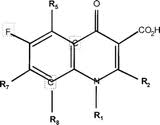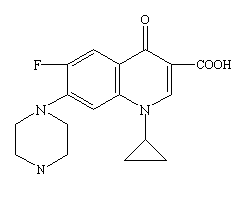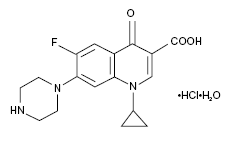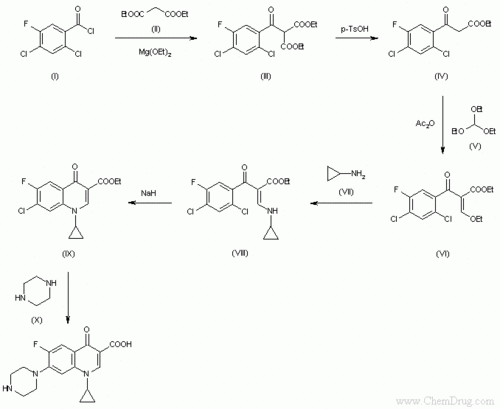Ciprofloxacin
From Proteopedia
(Difference between revisions)
| Line 69: | Line 69: | ||
=== DNA Gyrase Target === | === DNA Gyrase Target === | ||
| - | A twinned structure of <scene name='Sandbox_100/Dna_gyrase_normal/1'>DNA Gyrase from Staphylococcus aureus in complex with DNA and Ciprofloxacin</scene> is shown. DNA Gyrase is characterized by its "ironing device" appearance with a <scene name='Sandbox_100/General_gyrase_form_with_dna/1'>base cleft forming the active site for interaction with DNA</scene> (in this scene, DNA Gyrase is light blue, and the dip-like cleft runs the length of the base of the protein; the DNA ligand is black and Ciprofloxacin, as in all scenes under this heading, maintains its atomic color labels). Ciprofloxacin intercalates on DNA at <scene name='Sandbox_100/Outzoom_gyrase_photo_cipro/1'>sites within this cleft</scene> (in this scence, DNA is light brown and is in ball-and-stick formation). Ciprofloxacin inhibits the progression of DNA Gyrase on DNA by attacking and stabilizing successive coils of DNA for <scene name='Sandbox_100/Cipro_in_gyrase/1'>intercalation between corresponding successive grooves of DNA</scene> (in this scene DNA is in mesh formation). The | + | A twinned structure of <scene name='Sandbox_100/Dna_gyrase_normal/1'>DNA Gyrase from Staphylococcus aureus in complex with DNA and Ciprofloxacin</scene> is shown. DNA Gyrase is characterized by its "ironing device" appearance with a <scene name='Sandbox_100/General_gyrase_form_with_dna/1'>base cleft forming the active site for interaction with DNA</scene> (in this scene, DNA Gyrase is light blue, and the dip-like cleft runs the length of the base of the protein; the DNA ligand is black and Ciprofloxacin, as in all scenes under this heading, maintains its atomic color labels). Ciprofloxacin intercalates on DNA at <scene name='Sandbox_100/Outzoom_gyrase_photo_cipro/1'>sites within this cleft</scene> (in this scence, DNA is light brown and is in ball-and-stick formation). Ciprofloxacin inhibits the progression of DNA Gyrase on DNA by attacking and stabilizing successive coils of DNA for <scene name='Sandbox_100/Cipro_in_gyrase/1'>intercalation between corresponding successive grooves of DNA</scene> (in this scene DNA is in mesh formation). The effect of this intercalation on the specific base pairs of participating nucleotides is shown <scene name='Sandbox_100/Another_angle_with_cartoon_dna/1'>here, with base pairs folding out against the interrupting Ciprofloxacin</scene>.This intercalation and consequent stabilization prevents proper unwinding of DNA by DNA Gyrase. An example of specifically interrupted sites on the DNA strand is shown <scene name='Sandbox_100/Spec_grn_dna_interruption_cipr/2'>here, with specifically interrupted DNA in green</scene>. The precise mechanism by which Ciprofloxacin interaction with DNA Gyrase ultimately leads to cell death has not been elaborated fully. However, examination of the location of intercalation of Ciprofloxacin with respect to the amino acid residues of DNA Gyrase near this location leads to the observation that the characteristically polar atoms within the structure of Ciprofloxacin (i.e. fluorine, oxygen, nitrogen) seem to interact with the <scene name='Sandbox_100/Polar_on_polar_gyrase_on_cipro/1'> characteristically polar amino acid residues of DNA Gyrase</scene> (in this scene, all polar amino acid residues are blue). A broader analysis indicates that this location, the active site of the protein, is composed, primarily, of <scene name='Sandbox_100/Helix_composition_of_act_site/1'>alpha helices</scene> (in this scene, alpha helices are purple, beta sheets and turns are brown for comparison; DNA is portrayed in dot formation, and Ciprofloxacin is not shown). |
{{Clear}} | {{Clear}} | ||
Revision as of 15:41, 26 June 2013
| |||||||||||
References
- ↑ CIPRO® (ciprofloxacin hydrochloride) TABLETS - CIPRO® (ciprofloxacin*) ORAL SUSPENSION - Drug Information Packet. Bayer HealthCare Pharmaceuticals. Schering Plough Corporation.
- ↑ CIPRO® (ciprofloxacin hydrochloride) TABLETS - CIPRO® (ciprofloxacin*) ORAL SUSPENSION - Drug Information Packet. Bayer HealthCare Pharmaceuticals. Schering Plough Corporation.
- ↑ 2011. Ciprofloxacin. Medicine Plus. American Society of Health-System Pharmacists Inc. 2011. http://www.nlm.nih.gov/medlineplus/druginfo/meds/a688016.html.
- ↑ 2001. Information on Cipro (Ciprofloxacin Hydrochloride) for Inhalation Anthrax for Consumers: Questions and Answers. Fda.gov. http://www.fda.gov/Drugs/EmergencyPreparedness/BioterrorismandDrugPreparedness/ucm130711.htm. Last updated, 2009.
- ↑ 2011. Ciprofloxacin. Medicine Plus. American Society of Health-System Pharmacists Inc. 2011. http://www.nlm.nih.gov/medlineplus/druginfo/meds/a688016.html.
- ↑ Ciprofloxacin. (2010). Pcm.me. http://pcm.me/ciprofloxacin/.
- ↑ Ciprofloxacin - Activity, Business Aspects/Bayer Pharmaceutical. Encyclopedia.jrank.org. http://encyclopedia.jrank.org/articles/pages/1398940/Ciprofloxacin.html
- ↑ Siegmund, K., et al. (2005). Molecular details of quinolone-DNA interactions: solution structure of an unusually stable DNA duplex with covalently linked nalidixic acid residues and non-covalent complexes derived from it. Nucleic Acids [Research], 33(15), 4838-4848.
- ↑ Peterson, L. (2001). Quinolone-Molecular Structure-Activity Relationships: What We Have Learned About Improving Antimicrobial Activity. Clinical Infectious Diseases, 33(3), S180-S186.
- ↑ Image from: http://cid.oxfordjournals.org/content/33/Supplement_3/S180.full.
- ↑ CIPRO® (ciprofloxacin hydrochloride) TABLETS - CIPRO® (ciprofloxacin*) ORAL SUSPENSION - Drug Information Packet. Bayer HealthCare Pharmaceuticals. Schering Plough Corporation.
- ↑ Molecular weight from Chemexper.com.
- ↑ CIPRO® (ciprofloxacin hydrochloride) TABLETS - CIPRO® (ciprofloxacin*) ORAL SUSPENSION - Drug Information Packet. Bayer HealthCare Pharmaceuticals. Schering Plough Corporation.
- ↑ Image from: http://www.google.com/imgres?imgurl=http://textbookofbacteriology.net/themicrobialworld/cipro.gif&imgrefurl=http://textbookofbacteriology.net/themicrobialworld/control.html&usg=__wtzKLHB3NssfnODEB224br5-Bcw=&h=200&w=250&sz=2&hl=en&start=0&zoom=1&tbnid=o7VT7s6FFIUrWM:&tbnh=160&tbnw=199&ei=Hk10TaypBcL58AbyvIjKDw&prev=/images%3Fq%3Dciprofloxacin%26um%3D1%26hl%3Den%26client%3Dfirefox-a%26sa%3DN%26rls%3Dorg.mozilla:en-US:official%26biw%3D1280%26bih%3D647%26tbs%3Disch:1&um=1&itbs=1&iact=hc&vpx=527&vpy=300&dur=1709&hovh=160&hovw=200&tx=155&ty=82&oei=EU10TcvOCMbdtge5msiLDw&page=1&ndsp=16&ved=1t:429,r:7,s:0.
- ↑ Molecular weight from: CIPRO® (ciprofloxacin hydrochloride) TABLETS - CIPRO® (ciprofloxacin*) ORAL SUSPENSION - Drug Information Packet. Bayer HealthCare Pharmaceuticals. Schering Plough Corporation.
- ↑ Image from: http://www.google.com/imgres?imgurl=http://images.rxlist.com/images/rxlist/ciloxan_s.gif&imgrefurl=http://www.rxlist.com/ciloxan_ophthalmic_ointment-drug.htm&usg=__UqTKseSe8hD85c5RLGIz2_dbAg0=&h=142&w=232&sz=2&hl=en&start=16&zoom=1&tbnid=70Q2WG5hppsQ5M:&tbnh=100&tbnw=164&ei=T010TenMFYH_8Aa6gvDKDw&prev=/images%3Fq%3Dciprofloxacin%26um%3D1%26hl%3Den%26client%3Dfirefox-a%26sa%3DN%26rls%3Dorg.mozilla:en-US:official%26biw%3D1280%26bih%3D647%26tbs%3Disch:10%2C624&um=1&itbs=1&iact=hc&vpx=1064&vpy=399&dur=309&hovh=106&hovw=174&tx=98&ty=76&oei=EU10TcvOCMbdtge5msiLDw&page=2&ndsp=18&ved=1t:429,r:17,s:16&biw=1280&bih=647.
- ↑ Ciprofloxacin. (2010). Pcm.me. http://pcm.me/ciprofloxacin/.
- ↑ Image from: http://www.google.com/imgres?imgurl=http://www.chemdrug.com/databases/SYNTHESIS/SYN/09/09000601a.gif&imgrefurl=http://www.chemdrug.com/databases/8_0_dvpytumicutbciwa.html&usg=__TxiDuzCve6C_crxmcPYTpfW5d4s=&h=555&w=678&sz=6&hl=en&start=0&zoom=1&tbnid=xhquLksJBbMnjM:&tbnh=165&tbnw=201&ei=0Y93TdbGI-yI0QGspa25Bw&prev=/images%3Fq%3Dsynthesis%2Bof%2Bciprofloxacin%26um%3D1%26hl%3Den%26client%3Dfirefox-a%26sa%3DN%26rls%3Dorg.mozilla:en-US:official%26biw%3D1280%26bih%3D647%26tbs%3Disch:1&um=1&itbs=1&iact=hc&vpx=346&vpy=105&dur=63&hovh=203&hovw=248&tx=170&ty=128&oei=0Y93TdbGI-yI0QGspa25Bw&page=1&ndsp=16&ved=1t:429,r:1,s:0
- ↑ Ciprofloxacin Oral - Monograph - Ciprofloxacin Hydrochloride. 2009. Medscape.com. http://www.medscape.com/druginfo/monograph cid=med&drugid=7748&drugname=Ciprofloxacin+Oral&monotype=monograph&secid=8.
- ↑ Su, Chih-Chia, et al. (2006). Conformation of the AcrB Multidrug Efflux Pump in Mutants of the Putative Proton Relay Pathway. Journal of Bacteriology, 188(20), 7290-7296.
- ↑ Husain, F., Nikaido, H. (2010). Substrate path in the AcrB multidrug efflux pump of Escherichia coli. Molecular Microbiology, 78(2), 320-330.
- ↑ Su, Chih-Chia, et al. (2006). Conformation of the AcrB Multidrug Efflux Pump in Mutants of the Putative Proton Relay Pathway. Journal of Bacteriology, 188(20), 7290-7296.
Proteopedia Page Contributors and Editors (what is this?)
John Ripollone, John E. Ripollone, Alexander Berchansky, David Canner




